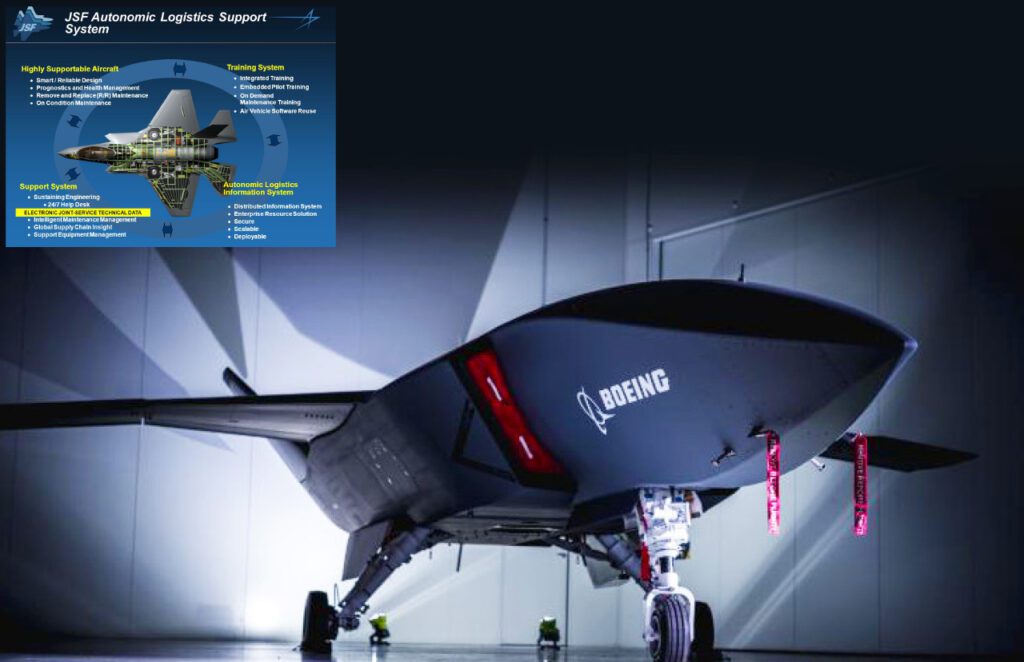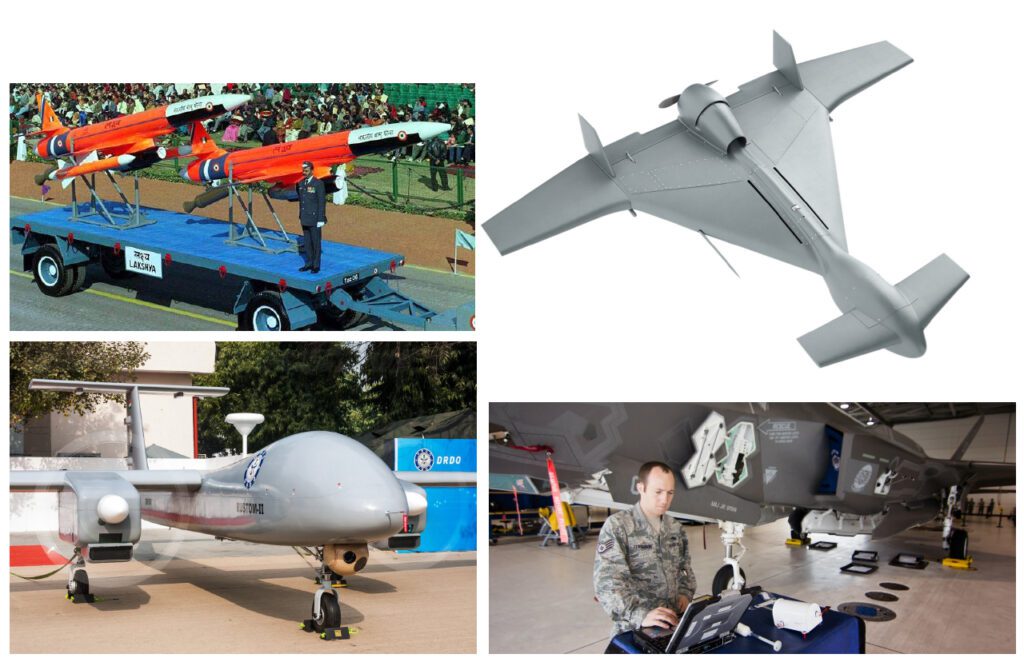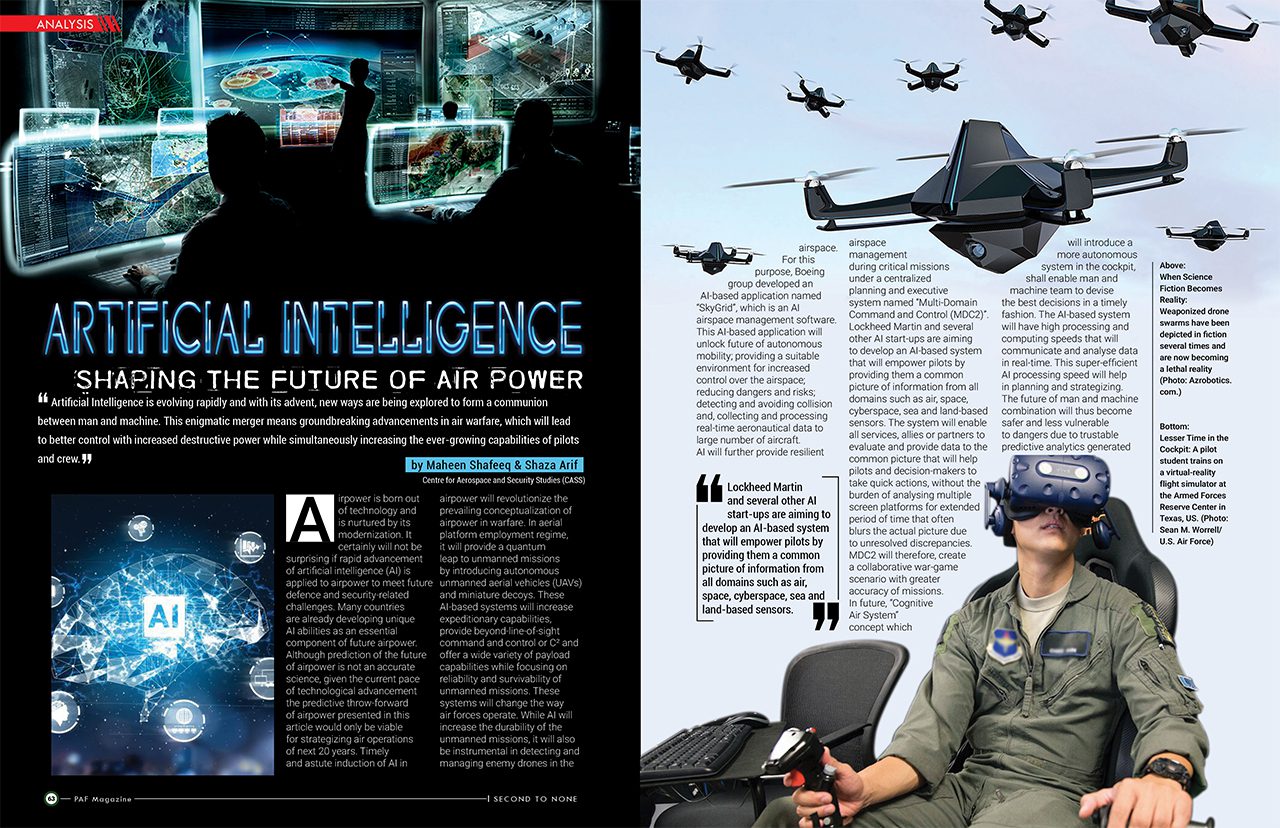Artificial Intelligence is evolving rapidly and with its advent, new ways are being explored to form a communion between man and machine. This enigmatic merger means groundbreaking advancements in air warfare, which will lead to better control with increased destructive power while simultaneously increasing the ever-growing capabilities of pilots and crew.
Airpower is born out of technology and is nurtured by its modernization. It certainly will not be surprising if rapid advancement of artificial intelligence (AI) is applied to airpower to meet future defence and security-related challenges. Many countries are already developing unique AI abilities as an essential component of future airpower. Although prediction of the future of airpower is not an accurate science, given the current pace of technological advancement the predictive throw-forward of airpower presented in this article would only be viable for strategizing air operations of next 20 years. Timely and astute induction of AI in airpower will revolutionize the prevailing conceptualization of airpower in warfare. In aerial platform employment regime, it will provide a quantum leap to unmanned missions by introducing autonomous unmanned aerial vehicles (UAVs) and miniature decoys. These AI-based systems will increase expeditionary capabilities, provide beyond-line-of-sight command and control or C² and offer a wide variety of payload capabilities while focusing on reliability and survivability of unmanned missions. These systems will change the way air forces operate. While AI will increase the durability of the unmanned missions, it will also be instrumental in detecting and managing enemy drones in the airspace.
For this purpose, Boeing group developed an AI-based application named “SkyGrid”, which is an AI airspace management software. This AI-based application will unlock future of autonomous mobility; providing a suitable environment for increased control over the airspace; reducing dangers and risks; detecting and avoiding collision and, collecting and processing real-time aeronautical data to large number of aircraft.
AI will further provide resilient airspace management during critical missions under a centralized planning and executive system named “Multi-Domain Command and Control (MDC2)”. Lockheed Martin and several other AI start-ups are aiming to develop an AI-based system that will empower pilots by providing them a common picture of information from all domains such as air, space, cyberspace, sea and land-based sensors. The system will enable all services, allies or partners to evaluate and provide data to the common picture that will help pilots and decision-makers to take quick actions, without the burden of analysing multiple screen platforms for extended period of time that often blurs the actual picture due to unresolved discrepancies. MDC2 will therefore, create a collaborative war-game scenario with greater accuracy of missions.

In future, “Cognitive Air System” concept which will introduce a more autonomous system in the cockpit, shall enable man and machine team to devise the best decisions in a timely fashion. The AI-based system will have high processing and computing speeds that will communicate and analyse data in real-time. This super-efficient AI processing speed will help in planning and strategizing. The future of man and machine combination will thus become safer and less vulnerable to dangers due to trustable predictive analytics generated by AI algorithms, which will ultimately increase the war fighter’s efficiency and lower the cost when stakes are high.
War fighting efficiency will further increase as AI will be able to absorb more data on the battleground that will ease the pilots’ burden during critical missions. In next-generation aircraft, AI will become the best partner of pilots who, with advanced warfare techniques and concepts, will have more and more synthesised information to observe, process and respond to while in the cockpit. In this capacity, AI will gather, monitor, sense, filter and compare historical data with real-time data, under limited time and provide the most relevant information to the pilots to accomplish their missions while avoiding threats.
As warfare technologies are evolving, a swarm of threats is emerging. One of the most critical threats posed is adaptive radars. AI and machine learning may be able to help in this scenario by differentiating between 5G and other radio frequencies; thus, providing more awareness to the user during critical missions. BAE Systems is working with DARPA to bring AI to the radio frequency domain that will detect, decode and distinguish radio frequency signals sent out by the adversary communication or radar system. It will become an important component in an increasingly crowded RF spectrum especially in electronic warfare. These RF AI systems will make sense of RF signals intercepted from the enemy to anticipate threats and provide real-time analysis of the battle-space; in turn enabling faster adaptation to tactics of the adversary.
In most cases, an adversary’s first tactic during the aerial confrontation is jamming the communication and radar system of hostile aircraft. To address this issue, AI will provide the reverse solution to this problem. From an embedded computing standpoint, AI will enable space-time adaptive processing (STAP) radar and cognitive electronic warfare (CEW) that will overcome the jamming techniques of the adversary. It will employ AI to better jam the adversary’s radar or disable the enemy’s jammer completely while giving them a false picture that everything is working as per plan.
AI will not only enhance survivability factors during critical missions but it will also look after the health of the aircraft. AI-enabled predictive aircraft maintenance and repair software for aircraft will provide real-time technical data of maintenance and suggest upgrades required in an aircraft. This approach is currently utilized by F-35’s Autonomic Logistics Information System (ALIS) that collects data from real-time sensors embedded in the engine and on-board systems of the aircraft and feeds on AI application that determines which parts of the aircraft need to be replaced or inspected. The advancement in AI is still an on-going process with an open-architecture approach that will allow insertion of new capabilities to continuously upgrade and uplift the airpower’s performance and abilities. However, the AI also creates threatening aspects that might lower the humane curve of this technological advancement.
On the other hand, the opportunities that AI is introducing to strengthen airpower may or may not be interpreted aptly by the operators or programmers. The possibility that machines will overwhelm human warfare skills remain an important issue for consideration. If airpower is considered, a pressing aspect engulfed with AI is the level of autonomy that is to be imparted to engage their targets. Technology experts such as Elon Musk and Stephan Hawking have repeatedly asserted that artificial intelligence is an extremely dangerous technology and can present challenges that are alien to policymakers. Once it crosses a certain threshold, human beings are withdrawn of any control over it. Consequently, the experts have stressed upon the fact that humans should always be kept in the loop and have oversight over the operations being executed by AI-powered aerial vehicles. Conversely, for certain policymakers, human oversight is considered as a hindrance in technological advancement, as machine learning can enable task execution at a much expedited rate as compared to human decision making.

The lethal potentials of autonomous aerial drones cannot be compared to those of fighter jets or other conventional weaponry, paving way for uncertainty and leaving ample room for escalation in a case where machine misinterprets the intentions of its adversary.
Furthermore, enhancing the airpower capabilities comes with the legal obligations to abide by the Law of Armed Conflict (LOAC). AI does not differentiate between soldiers and civilians. The delegation of power to autonomous weapons can put the lives of civilians into grave dangers in case a conflict emerges. Likewise, post-conflict, attribution challenges will also be posed as to who should be held responsible if humanitarian laws were not abided by.
If the progress of strengthening airpower with AI is considered; frontrunners in the field are USA and China and to some extent Russia In addition, South Asia has witnessed the trend of militarization of AI. China, in particular, has made expeditious efforts in the field of AI and aims to be AI leader by 2030. Chinese forces have made significant progress with UAVs and are heavily investing in Swarming technology.
Likewise, India envisions itself as a rising power and has also jumped into the race of militarization of AI. Though it will take India a number of years to make significant advancements in AI, initial steps on the trajectory of this future technology has already been taken. The Centre for Artificial Intelligence and Robotics (CAIR) established in 1986, by the Defence Research and Development Organization (DRDO) is facilitating research and innovation in AI, assisting the armed forces to integrate it in the latest weaponry.
Rustom, Nishant and Lakshya are some of the autonomous drones; developed by DRDO, which are to be used in intelligence, reconnaissance and surveillance (ISR) operations. In 2019, an agreement for purchase of 54 Israeli HAROP killer drone was signed which will supplement the existing capability of 110 such drones.
The Indian armed forces are already taking the aid of UAVs for border control, reconnaissance and maritime patrol. Swarming technology has also been sought to a great extent and India is encouraging start-up projects in this regard.
Considering regional security dynamics and the recent aerial exchange between India and Pakistan; there is ample room for a limited conflict. The blend of robust air defence systems comprising of the S-400 and AI-equipped aerial capabilities may act as a potent incentive for India to conduct any misadventure in Pakistani territory. In future wartime scenarios, these autonomous UAVs can lead to escalation between the arch-rivals and bring us to a stage where de-escalation might be difficult.
Lastly, artificial intelligence will redefine the dynamics of airpower in future. Air forces will be inclined to employ this technology to make them more efficient and compelling. In addition, artificial intelligence is sustainable when it is developed through indigenous resources. Universities, private companies and research institutions will be pivotal for transformation of future air forces. Consequently, Pakistan must endeavour to develop potential platforms which can play an effective role to make speedy advancement in this emerging field and play a transformative role for its air force.








